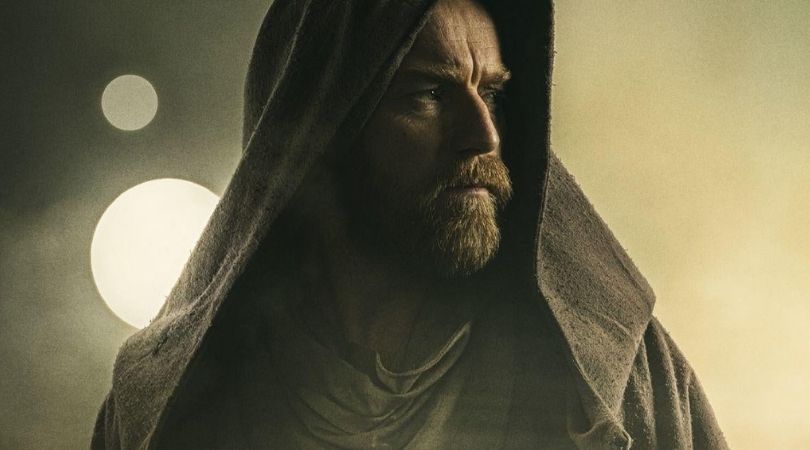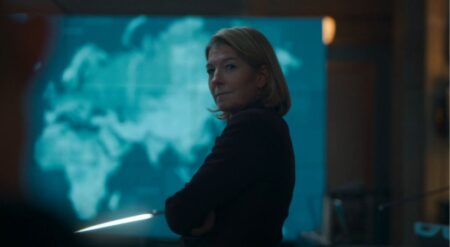
Obi-Wan’s connection to the Skywalker children is one of the most compelling elements of Star Wars for me. A mentor, a brother, and now a father figure of sorts, Obi-Wan Kenobi brings back Ewan McGregor and Hayden Christensen to close out their story – or at least in the time between Star Wars: Revenge of the Sith and Star Wars: A New Hope. Directed by Deborah Chow, the mini-series spans six parts running between 43 minutes to just over 50. But while the short episode order has hurt other Disney+ series, here it works.
Obi-Wan Kenobi begins ten years after the events of Revenge of the Sith, where Obi-Wan (Ewan McGregor) faced his greatest defeat and biggest mistake, the corruption of his best friend, Jedi apprentice, and brother Anakin Skywalker (Hayden Christensen). Now, turned to the Dark Side and emerged as evil Sith Lord Darth Vader (Christensen/James Earl Jones), Kenobi must reckon with his past and the choices he’s made while the remaining Jedi and force-sensitive people of the galaxy continue to hide from the remnants of the brutal Order 66.
To start, Obi-Wan Kenobi exists in a fairly saturated space of Star Wars content. The time from the Prequels to the Original Trilogy has been packed with content, from animation to books, comics, and more. This saturation was my concern for the series. Had the series written itself into a corner? Could it keep the stakes while bridging the temporal gap between storylines?
For the former, the answer is no, and, well, it’s also a no to the latter. While the mini-series manages to have a wide breadth of narrative choices that feel organic instead of structures driven exclusively by continuity, the fact remains that Vader can’t die, Leia (Vivien Lyra Blair) can’t die, Obi-Wan can’t die, Bail can’t die, you get the idea. We have a long list of characters that have to survive and, as such, undoes the stakes and undercuts moments unintentionally in the process. That said, this doesn’t mean that the series doesn’t do the most with what it’s given in order to bridge the gap extremely well.
One of the ways Obi-Wan Kenobi does this is by giving a reason for the specter of evil that the Empire casts, even without being present. This is done primarily through the Inquisitors. Bringing out characters from the animated series and introducing new ones, the Empire and the dark side is beefed out in an impressive way. The largest of which is with Third Sister Reva (Moses Ingram), an Inquisitor with immense skill and anger fueling her every move.
Played by Moses Ingram, Reva is intimidation personified. She is rage, and she is hatred. Formed by the systems around her and one of the largest tragedies in the Star Wars universe, she has a power that takes up every room she enters. A commanding presence with one focus, Reva is easily a fantastic addition to Star Wars, even if her mirrored path with Anakin’s hits beats too much on the head.
But to balance the evil, we also get a little Leia. With the football being passed between the antagonists and the protagonist, Leia could have easily been a prop for the story; instead, she has agency. She drives her own story as much as she is used to push Obi-Wan on his path of attempted redemption from his past. Most stunning of all, however, is how effortlessly Vivien Lyra Blair holds her own when acting opposite Ingram and McGregor. Instead of falling to the wayside in the long list of child actors who are there to be props, Blair takes on the job of being Princess Leia brilliantly.
Little Leia is tenacious and curious in a way that draws a straight line to who she will be in the future. But most importantly, this is because she is her parents. She is Padme, and she is Anakin, but more importantly, she is an Organa, something her father Bail instills in her in the series’ first episode. There is something beautiful in seeing the Organa family, particularly Bail’s role in raising her. Leia is aware of the world beyond her royalty and is moved by it, even if it robs her of her childhood.
Even with a strong extended cast, Obi-Wan Kenobi is at its best when it comes from its titular lead. Obi-Wan is a broken man. His entire sense of being has been shattered. The Jedi, as an institution, are destroyed, his connections to the world are dead, and now he’s alone. He’s alone both by necessity and choice as he overcorrects for his attachments in the past and the pain his inability to kill has reaped across the galaxy. Filled with grief and regret, Obi-Wan is a flawed man and a flawed hero, and that’s what makes his journey special. Through his pain of reconnecting and caring again, we get to see a man reckoning with his past while also realizing that his choices weren’t inherently bad.
Obi-Wan’s loving and tender connection with Leia is one that never infantilizes her. Instead, he sees the little Princess of Alderaan and the dark world she is in. He trusts her as much as he protects her, and in a similar way to Anakin, he loves her. As he forges his relationship with Leia, the pieces begin to come together, filling in the gaps as to why Leia trusts him implicitly in A New Hope. This relationship works beautifully to show Obi-Wan forgiving himself and forming new attachments instead of isolating himself even further.

For the most part, Obi-Wan Kenobi is without fault. It builds a compelling extended cast with Reva and Leia while offering interesting tertiary characters like Tala (Indira Varma) and Haja Estree (Kumail Nanjiani). That said, there are elements that wind up as anticlimactic moments, particularly the first confrontation between Obi-Wan and Vader. Additionally, Vader is still the eternal boogeyman we know him to be, but he lacks the brutality we saw in the closing moments of Rogue One. He is the specter of evil hanging over the galaxy, yet we still don’t get to see the scale at which he executes hit brutality.
But in all this, the series’ largest fault lies in its excessive use of natural lighting, which obscures many of the details in the series. While it looks stellar during lightsaber battles, for the series’ brown and Black characters, the visual darkness of the show washes them out on screen. With such powerful and beautiful women like Varma and Ingram on screen, it’s a disservice to them and their characters. Deborah Chow understands how to show characters as epic myths and vulnerable individuals, but I just need her to turn on a light.
At the end of the day, Obi-Wan Kenobi as a series may not be necessary for every fan, but its little moments of connection, love, anger, and grief work to create a series that has more heart than spectacle. Working in the small moments between characters, there is enough added to the Star Wars universe that makes me say: watch it.
Obi-Wan Kenobi is now streaming in its entirety exclusively on Disney+.
Obi-Wan Kenobi
-
Rating - 7.5/107.5/10
TL;DR
Obi-Wan Kenobi as a series may not be necessary for every fan, but its little moments of connection, love, anger, and grief work to create a series that has more heart than spectacle. Working in the small moments between characters, there is enough added to the Star Wars universe that makes me say: watch it.







